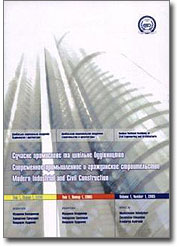Investigation of the Influence of the Destroyed Object Position relative to the Extreme Support of the Excavator on the Efficiency of the Hydraulic Hammer Working Process
Abstract: The developed mathematical model of working process of the system «excavator-hammer» takes into account design parameters of the breaker and properties of the destroyed object. Using the developed mathematical model, a computational experiment was performed, as a result of which diagrams of the forces arising in the structural elements of the excavator and hydraulic hammer were constructed: in the stroke limiters of the wedge, in the stroke limiters of the striker, in the suspension of the excavator and attached to the destroyed material. It was found that with the maximum extension of attachments (boom and hydraulic hammer handle), the value of the reduced weight of the excavator practically does not affect the forces in its suspension, and they are maximum for the entire range of measurements. It is established that the position of the destroyed object relative to outer supports of the excavator has a significant impact on workflow efficiency breaker; minimal removal of the destroyed object allows you to implement almost in half twice great efforts impact on destructible material with minimal effort in the suspension of the excavator.
Keywords: hydraulic hammer, excavator, force, object of destruction, excavator suspension.
Pages: 15-22.
For citation:
For citation: Arifyev, Ye. M.; Matvienko, S. A.; Komlev, V. V. Investigation of the Influence of the Destroyed Object Position relative to the Extreme Support of the Excavator on the Efficiency of the Hydraulic Hammer Working Process. – Text : electronic. – In: <em>Modern Industrial and Civil Construction</em>. – 2020. – Vol. 16, N 1. – Р. 15-22. – URL: https://donnasa.ru/publish_house/journals/spgs/2020-1/02_arifyev_matvienko_komlev.pdf (date of access: 22.12.2024). – ISSN 1993-3495.

Vol. 16, N 1 (2020)
Journal: Modern Industrial and Civil Construction
Publish house: Donbas National Academy of Civil Engineering and Architecture
Journal: Modern Industrial and Civil Construction
Publish house: Donbas National Academy of Civil Engineering and Architecture
